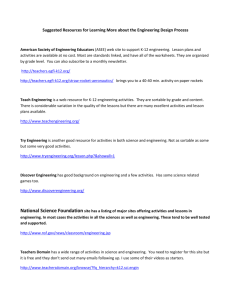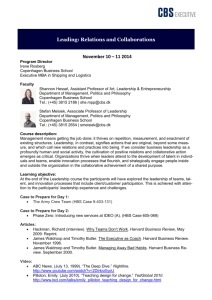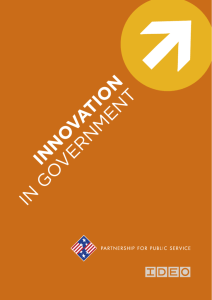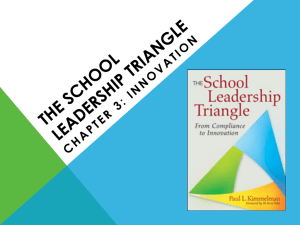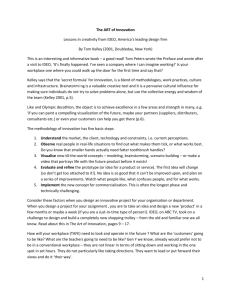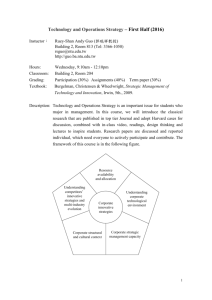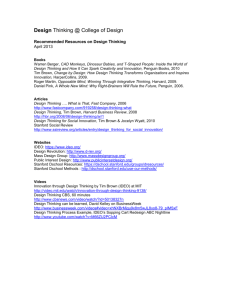the deep dive
advertisement
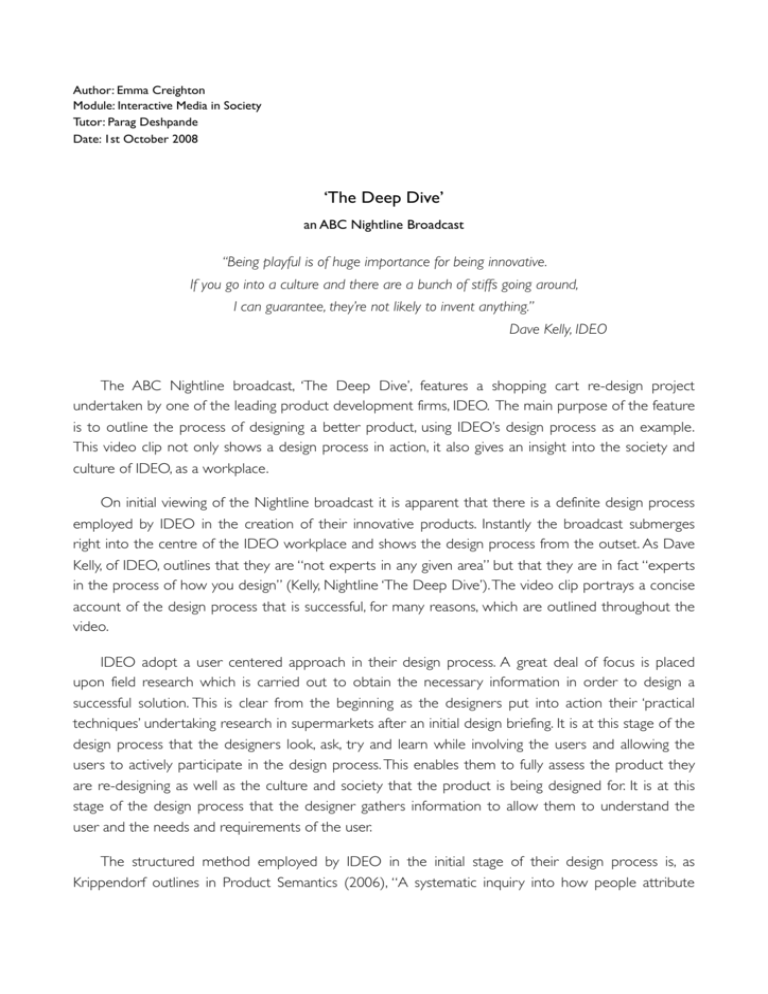
Author: Emma Creighton Module: Interactive Media in Society Tutor: Parag Deshpande Date: 1st October 2008 ‘The Deep Dive’ an ABC Nightline Broadcast “Being playful is of huge importance for being innovative. If you go into a culture and there are a bunch of stiffs going around, I can guarantee, they’re not likely to invent anything.” Dave Kelly, IDEO The ABC Nightline broadcast, ‘The Deep Dive’, features a shopping cart re-design project undertaken by one of the leading product development firms, IDEO. The main purpose of the feature is to outline the process of designing a better product, using IDEO’s design process as an example. This video clip not only shows a design process in action, it also gives an insight into the society and culture of IDEO, as a workplace. On initial viewing of the Nightline broadcast it is apparent that there is a definite design process employed by IDEO in the creation of their innovative products. Instantly the broadcast submerges right into the centre of the IDEO workplace and shows the design process from the outset. As Dave Kelly, of IDEO, outlines that they are “not experts in any given area” but that they are in fact “experts in the process of how you design” (Kelly, Nightline ‘The Deep Dive’). The video clip portrays a concise account of the design process that is successful, for many reasons, which are outlined throughout the video. IDEO adopt a user centered approach in their design process. A great deal of focus is placed upon field research which is carried out to obtain the necessary information in order to design a successful solution. This is clear from the beginning as the designers put into action their ‘practical techniques’ undertaking research in supermarkets after an initial design briefing. It is at this stage of the design process that the designers look, ask, try and learn while involving the users and allowing the users to actively participate in the design process. This enables them to fully assess the product they are re-designing as well as the culture and society that the product is being designed for. It is at this stage of the design process that the designer gathers information to allow them to understand the user and the needs and requirements of the user. The structured method employed by IDEO in the initial stage of their design process is, as Krippendorf outlines in Product Semantics (2006), “A systematic inquiry into how people attribute meanings to artifacts and interact with them accordingly”. Their user centred approach is “a vocabulary and methodology for designing artifacts in view of the meanings they could acquire for their users and the communities of their stakeholders” (Krippendorf, 2006, Product Semantics). IDEO reaslise that they need to observe , interact and talk to the users of the artefact that they are designing in order to learn the ‘meanings’ that the artefact has for the user. This approach enables the to successfully design innovative products. At IDEO the information gathered during the initial stage of the process is then presented. This stage is followed by an intensive brainstorming session which at IDEO is called ‘the deep dive’. It is during this stage of the process that requirements are drawn up and ideas are generated. The Nightline broadcast outlines this element of the design process in good detail, showing the mantra of the company; ‘one conversation at all times, stay focused on the topic, encourage wild ideas, defer judgement’. This stage of the process is described as ‘focused chaos’, where the staff are totally immersed in the problem at hand. The hundreds of ideas generated during ‘the deep dive’ put on the wall are then voted upon by the designers themselves. After this stage, the focus is then re-ordered by the ‘self appointed group of adults’, as they are dubbed in the Nightline programme. This is one of the few times that the viewer is shown a hierarchy type approach in the IDEO design process. The process now moves onto a focus on the needs of the user at the design stage. Four teams design under individual ‘need areas’, developing designs and prototypes. These prototypes are then scrutinized in preparation for the final stages of the design process. The four concepts are then combined and re-designed into a final design, resulting in a final working prototype. The final stage of the design process shown is then evaluated in context, gathering further feedback. The results are clear that the IDEO design process employed in the design of IDEO products, such as the example of the shopping cart, is successful. However it is not the design process alone that is documented in this programme. On examination of the video clip one gathers more of an insight into the deeper issues of society and culture and how these in turn affect the overall ethos of the company, what makes the company work so well and what are the factors that make it so successful. It is the society and culture that has been built within the IDEO workplace that leads to such innovative work. It can be seen from the video that there is a great deal of emphasis placed on teamwork. The staff are essentially a group of individuals who directly interact with each other, thus defining them as a society in themselves. Similarly the IDEO way of working or way of life can be seen as a culture. It is the culture and society built within the workplace of IDEO that makes them such a successful and influential product development firm. Dave Kelly himself refers to the culture within IDEO as an ‘innovative culture’. This ‘innovative culture’ is not the product of lone individuals, it is an evolving product of the staff at IDEO interacting with each other. It can be seen throughout the broadcast that hierarchy is not important in the workplace at IDEO. In the opening few minutes and throughout the video clip, the viewer is shown a group of equal individuals working together. As the staff are introduced, there are no titles among and no assignment, except in the case of Dave Kelly and Peter Skillman, team leader. It is only at crucial points of the design process that hierarchy comes into play to focus and re-direct the process if the need arises. It is this structure of people working together and interacting on the same level that creates the right type of culture. Communication is also key at IDEO. This is an important factor as communication can be seen as a way of binding people, the staff at IDEO, together in a society. Throughout “The Deep Dive” common rituals of communication can be seen such as, sharing, participation, association, fellowship and the possession of a common faith. The fun and playful environment of the workplace built within IDEO also contributes to the success of the company, and creates the right type of society and culture in which individuals can be innovative. Within moments of viewing the ‘The Deep Dive’ it is apparent that IDEO workplace, “where the crazies live” is unlike any other. The staff are encouraged to create their own work space, thus allowing them to shape their own society in which the ‘play’ and work. A huge emphasis is based upon playfulness which is one of the contributing factors that leads to such an ‘innovative culture’, as it is referred to by Dave Kelly. At IDEO they have built a culture and a process where the staff routinely think of new exciting and ideas and develop these into final products. The ‘innovative culture’ that leads to such success has led to companies approaching IDEO to not only design products but also to remake their corporate cultures. As Dave Kelly states; “If you can build a culture and a process where you routinely come up with great ideas, thats what the companies really want.” ‘The Deep Dive’ broadcast is an accurate and useful account of a design process in action. The Nightline programme successfully outlines the process of how designing a better product is done, using IDEO’s design process as an example. The initial stages of the design process are documented well, however there is very little shown of the final design and prototyping stages. The full extent of the work involved at every step of the process has not been portrayed in enough detail portraying an inaccurate account of the full design process of taking the design from the initial concept and prototyping stage right through to the final design. The design process employed within IDEO is a successful approach to the design of products with the user at the center of the process. It is apparent that the ‘innovative culture’ and the society built within the workplace have a strong influence on the design process and can be seen as main contributing factors to the production of innovative designs.
